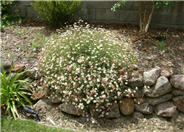
Common name:Santa Barbara Daisy, Mexican Daisy
Botanical name:Erigeron karvinskianus
This low mounding perennial, with fine leaves and white to pinkish daisy-like flowers, is an excellent asset to rock gardens. Capable of spreading.
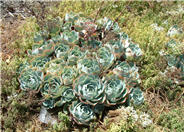
Common name:Hen and Chicks
Botanical name:Echeveria X 'Imbricata'
This succulent perennial is very small, growing only 2"-3" high. It produces orange, pink, and red blooms and does best in full sun and moist soil.
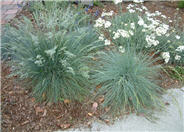
Common name:Common Blue Fescue, Blue Fescuegras
Botanical name:Festuca glauca
This groundcover/grass will grow less than 1' tall and has small, blue-green leaves.
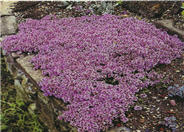
Common name:Mother-of-Thyme, Creeping Thyme
Botanical name:Thymus praecox arcticus
This evergreen groundcover needs full sun to light shade. It grows to 3" tall, forming a dense, thick mat. It needs well-drained, light soil. Creeping Thyme is considered drought tolerant. The foliage is dark green and slightly hairy. It has a pleasant, minty fragrance when crushed, though not considered for culinary uses. Flowers are lilac-purple and bloom in the summer. Attractive to bees and butterflies.
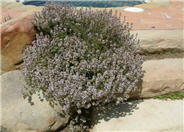
Common name:Purple Carpet Creeping Thyme
Botanical name:Thymus serpyllum 'Purple Carpet'
This perennial will grow about 3" tall and 3' wide. It has small, dark green leaves with clusters of purple-lavender flowers that bloom in spring and summer. Leaves are fragrant when crushed, can be used for seasoning.
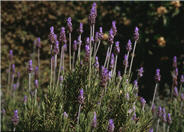
Common name:French Lavender, Toothed Lavender
Botanical name:Lavandula dentata
This lavender has green leaves and will grow 3' H x 5' W. It has lavender flowers that are prominent in the spring and summer months.
| Designer: | Elfin Thyme Loveliness |
Photographer: GardenSoft |
Soils and Compost:
Physical weed control, including mulching, or hand removal protects the watershed from harmful chemicals.
Water Saving Tip:
Use water saving equipment, e.g. rain or soil-moisture sensors, MP rotator nozzles, weather-based controllers, and low-volume irrigation (drip systems, soaker hoses, and microsprayers).
Integrated Pest Management:
Remove irrigation water and fertilizer from areas where you don't want weeds to grow.

